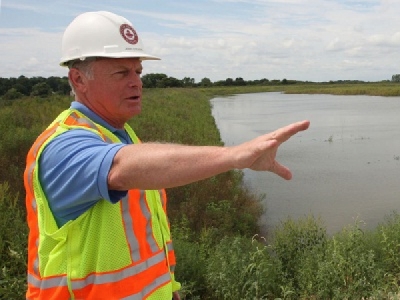
Posted on August 25, 2016
By Allison Petty, herald-review.com
Anyone driving across Lake Decatur on Lost Bridge Road can see the dredge working to remove sediment from the lake.
Two smaller dredges are also being assembled in the Sand Creek area, near Grove Road. Crews from Great Lakes Dredge & Dock, the city’s contractor on this $91 million job, use the machines to remove the sediment that has collected on the lake bottom, ultimately increasing the lake’s capacity.
But where does the sediment go? That’s harder for the average resident to see.
Once sediment is dislodged, it travels for miles through pipes that are mostly located on the lake bottom. Booster pumps along the way make sure that it keeps going, all the way to a 523-acre site off Angle Crossing Road in Oakley.
There, workers from subcontractor Terra Contracting Services have been working for more than two years to make sure the site can hold all the additional sediment that will be removed over the course of the six-year project.
They’re wrapping up now, said Jerry Stevens, engineering services coordinator for the city of Decatur. The crews began working at the site in February 2014, and have experienced numerous delays because of wet weather that made earthwork impossible.
Their task involved digging beneath the wet silt left from previous dredging efforts to find sturdier clay material, which they used to raise the berms around the site by 10 feet. They also raised the berms that separate different cells within the basin.
The berms were tested to ensure that they met certain compaction standards, as the site ultimately must hold millions of gallons of wet sediment.
The cells help filter sediment from the water that comes in with it, allowing the water ultimately to flow back to Lake Decatur, Stevens said.
“When the sediment comes in, it’s 85 percent water, 15 percent sediment. Then as it sits there, the sediment can settle out, just like it did in the lake,” Stevens said. “The clearer water stays on top. Then it goes into another cell, if there’s more sediment that needs to be taken out then it stays there.
“It doesn’t really flow real fast. It sits here for a long time to let it all settle out.”
After flowing through several cells and weirs, the water goes into a drainage ditch and then back into the lake. Stevens said it is regularly tested for total suspended solids, and the water flowing back in is clearer than the water in the lake now.
“We’re just taking the very clearest water off the top,” he said.
Crews from Terra have seeded the sides of the berms to stabilize them. From the road outside, they look like sides of a steep hill.
Within their boundaries, some areas look like a miniature lake, while others are more marshy and overgrown with plants. Ducks and other wildlife like the basin, Stevens said.
Dredging is expected to begin in the Sand Creek area later this summer, and it is ongoing in Basin 2.
All the pipes will be removed from the bottom of the lake once the project is complete, Stevens said.
“Nothing is going to be left in the lake,” he said.
Source: Herald & Review





